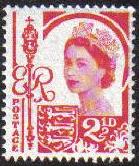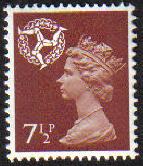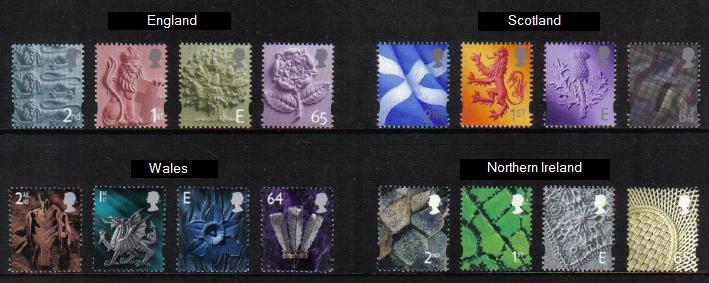
Country definitives
Encyclopedia

Postage stamp
A postage stamp is a small piece of paper that is purchased and displayed on an item of mail as evidence of payment of postage. Typically, stamps are made from special paper, with a national designation and denomination on the face, and a gum adhesive on the reverse side...
s issued for regions of the United Kingdom, reflecting the regional identity of the various countries and islands of the British isles.
Postage stamps were first issued by Great Britain in May 1840 and were valid throughout the United Kingdom of Great Britain and Ireland
United Kingdom of Great Britain and Ireland
The United Kingdom of Great Britain and Ireland was the formal name of the United Kingdom during the period when what is now the Republic of Ireland formed a part of it....
until 1922 and in the United Kingdom of Great Britain and Northern Ireland thereafter.
In 1958, special regional issues were introduced, with the Channel Islands
Channel Islands
The Channel Islands are an archipelago of British Crown Dependencies in the English Channel, off the French coast of Normandy. They include two separate bailiwicks: the Bailiwick of Guernsey and the Bailiwick of Jersey...
, Isle of Man
Isle of Man
The Isle of Man , otherwise known simply as Mann , is a self-governing British Crown Dependency, located in the Irish Sea between the islands of Great Britain and Ireland, within the British Isles. The head of state is Queen Elizabeth II, who holds the title of Lord of Mann. The Lord of Mann is...
, Northern Ireland, Scotland
Scotland
Scotland is a country that is part of the United Kingdom. Occupying the northern third of the island of Great Britain, it shares a border with England to the south and is bounded by the North Sea to the east, the Atlantic Ocean to the north and west, and the North Channel and Irish Sea to the...
and Wales
Wales
Wales is a country that is part of the United Kingdom and the island of Great Britain, bordered by England to its east and the Atlantic Ocean and Irish Sea to its west. It has a population of three million, and a total area of 20,779 km²...
receiving their own special issues. The designs used the same portrait as the Wildings
Wilding series
The Wildings were a series of definitive postage stamps featuring the Dorothy Wilding photographic portrait of Queen Elizabeth II that were in use between 1952 and 1967 until they were replaced by the Machin series.- History :...
, but were specially designed to incorporate the symbols of each of the home nations
Home Nations
Home Nations is a collective term with one of two meanings depending on the context. Politically, it means the nations of the constituent countries of the United Kingdom...
and Crown dependencies.
Northern Ireland, Scotland, Wales and Isle of Man regional stamps were changed to the Machins
Machin series
The Machin series of postage stamps is the main definitive stamp series in the United Kingdom, used since 5 June 1967. It is the second series to figure the image of Elizabeth II, replacing the Wilding series....
on decimalisation, with the relevant emblems shown in the top left hand corner. They were replaced between 1999 and 2000 with new designs for the four home nations.
While generally sold at post offices in their respective areas, all were valid throughout the UK and, until they became postally independent, the Crown Dependencies.
Abandoned idea in the 1940s
The idea of regional stamps came up after World War II to help the tourism in the Channel Islands, which were occupied by German forces until the end of the conflict. The concept was extended to all United Kingdom's regions and essays were prepared: positions of King George VIGeorge VI of the United Kingdom
George VI was King of the United Kingdom and the Dominions of the British Commonwealth from 11 December 1936 until his death...
's head and symbols.
1958 issues
Special committees were established to choose the heraldic emblems or symbols for the each country or island. These are discussed in the sections below. The first value (3d deep lilac) of the regional issues were introduced on 18 August 1958 in the Channel Islands, the Isle of Man, Scotland, Wales and Northern Ireland. The design consisted of the Dorothy WildingDorothy Wilding
Dorothy Wilding was a noted English society photographer from Gloucester. She wanted to become an actress or artist but this career was disallowed by her uncle, in whose family she lived, so she chose the art of photography which she started to learn from the age of sixteen.By 1929 she had already...
's portrait of the Queen surrounded by appropriate regional symbols. Other values were introduced at later dates. Some of the issue dates are unclear, as the stamps were first issued at the Philatelic Bureau in Edinburgh, others first at the Philatelic Counter in London, yet others first in the region.
The colours used were consistent across the various regions, and stayed constant with the exception of the 4d value, which was issued in three different colours – initially ultramarine, then olive-sepia and finally vermilion. The 4d's initial colour change was made to bring it into line with that used by the newly issued pre-decimal Machin series (from 5 June 1967 onwards). The Machin 4d's colour was then changed because of complaints that the date of postmarks (critical for football pool entries) could not be read on so dark a colour. All the regional 4d's were then changed again to the new Machin colour of vermilion.
Scotland
The Scottish Committee chose designs by, John B Fleming, Gordon F Huntly and Archie B Imrie.Wales
The symbols selected by the Welsh committe were a Welsh Dragon (passant) and the leek. Three designs by Reynolds Stone were chosen.Northern Ireland
There were perceived to be some particular problems creating the Northern Ireland definitives because of a lack of symbols that might be used to represent Northern Ireland while avoiding contentious political symbolism. The committee charged with organising the choice of design decided on Dorothy WildingDorothy Wilding
Dorothy Wilding was a noted English society photographer from Gloucester. She wanted to become an actress or artist but this career was disallowed by her uncle, in whose family she lived, so she chose the art of photography which she started to learn from the age of sixteen.By 1929 she had already...
's portrait of the Queen augmented with symbols: the Red Hand of Ulster (the emblem of the O’Neills – the royal house of Ulster); the Arms of Northern Ireland (without supporters); the six-pointed Crowned Star with the Red Hand; the Flax Plant (with or without leaves); and a Field Gate with Ulster pillars. Several local artists were chosen to present designs and one from each was chosen by the Queen. The artists were: Thomas Collins; Leonard Pilton; William Hollywood; Colin Middleton; Miss T Robinson. Three, Collins; Pilton and Hollywood were chosen to be issued.
The Isle of Man
-
- See also postage stamps and postal history of the Isle of Man
The Isle of Man stamps were designed by John Nicholson, included the tre cassyn (Three Legs) escutcheoned (on a shield), the three spurs looking rather like stars, and had a bordering ring-chain pattern based on designs on ancient Manx stone crosses.
Jersey and Guernsey
JerseyJersey
Jersey, officially the Bailiwick of Jersey is a British Crown Dependency off the coast of Normandy, France. As well as the island of Jersey itself, the bailiwick includes two groups of small islands that are no longer permanently inhabited, the Minquiers and Écréhous, and the Pierres de Lecq and...
and Guernsey
Guernsey
Guernsey, officially the Bailiwick of Guernsey is a British Crown dependency in the English Channel off the coast of Normandy.The Bailiwick, as a governing entity, embraces not only all 10 parishes on the Island of Guernsey, but also the islands of Herm, Jethou, Burhou, and Lihou and their islet...
became postally independent on 1 October 1969 when they each issued their own inaugural series (see Jersey Post
Jersey Post
Jersey Post is the licensed universal service provider of mail service for the bailiwick of Jersey.- History :Jersey Post was established by the Post Office Law 1969, in 1969 as a result of an Order in Council which enabled the Crown dependencies to establish independent postal services...
, Guernsey Post
Guernsey Post
Guernsey Post is the postal service for the island of Guernsey, Channel Islands. It includes a Philatelic Bureau, and regularly issues both definitive and commemorative stamps...
) although locally-produced stamps had been in use during the Occupation of the Channel Islands
Occupation of the Channel Islands
The Channel Islands were occupied by Nazi Germany for much of World War II, from 30 June 1940 until the liberation on 9 May 1945. The Channel Islands are two British Crown dependencies and include the bailiwicks of Guernsey and Jersey as well as the smaller islands of Alderney and Sark...
1940–1945. The Bailiwick
Bailiwick
A bailiwick is usually the area of jurisdiction of a bailiff, and may also apply to a territory in which the sheriff's functions were exercised by a privately appointed bailiff under a royal or imperial writ. The word is now more generally used in a metaphorical sense, to indicate a sphere of...
of Guernsey incorporates Alderney
Alderney
Alderney is the most northerly of the Channel Islands. It is part of the Bailiwick of Guernsey, a British Crown dependency. It is long and wide. The area is , making it the third-largest island of the Channel Islands, and the second largest in the Bailiwick...
, Herm
Herm
Herm is the smallest of the Channel Islands that is open to the public and is part of the Bailiwick of Guernsey. Cars are banned from the small island just like its Channel Island neighbour, Sark. Unlike Sark, bicycles are also banned...
and Sark
Sark
Sark is a small island in the Channel Islands in southwestern English Channel, off the French coast of Normandy. It is a royal fief, geographically located in the Channel Islands in the Bailiwick of Guernsey, with its own set of laws based on Norman law and its own parliament. It has a population...
which all used the Guernsey issues from 1969. Alderney has issued its own stamps since 1983 and these are valid throughout the Bailiwick of Guernsey.
Decimal issues

Definitive stamp
A definitive stamp is a postage stamp, that is part of a regular issue of a country's stamps available for sale by the postal service for an extended period of time...
. Each stamp had a reduced size portrait of Queen Elizabeth II by Arnold Machin
Arnold Machin
Arnold Machin O.B.E, R.A. was a British artist, sculptor, coin and stamp designer.Machin was born in Stoke-on-Trent in 1911. He started work at the age of 14 as an apprentice china painter at the Minton Pottery. During the Depression he learnt to sculpt at Stoke-on-Trent's Art School, which was...
with a national emblem in the top left corner, the latter designed by Jeffery Matthews
Jeffery Matthews
Jeffery Matthews is a British artist, specialising in postage stamp design. He conceived the Machin definitive series' colour palette in the mid-1980s.-Biography:...
. The emblems used were :
- Isle of Man: The triskelionTriskelionA triskelion or triskele is a motif consisting of three interlocked spirals, or three bent human legs, or any similar symbol with three protrusions and a threefold rotational symmetry. Both words are from Greek or , "three-legged", from prefix "τρι-" , "three times" + "σκέλος" , "leg"...
; - Northern Ireland: The "Red HandRed handThe red hand may refer to:* Red-handed - the common idiomatic phrase "[he was] caught red-handed," means 'caught in the act of a crime'* Red-handed tamarin* Red Hands - children's game* Red Hand Day* Red Hand of Ulster* Red Hand Defenders...
" in a star beneath a crown; - Scotland: The lion rampant;
- Wales: The Welsh dragon.
The colours of the Machin regionals were the same as those of the main Machin issues. There are a few exceptions, for example the 4½p regionals are a darker blue. Not all the values and colours of the main issue appear in the regionals, but as these designs remained in use in the other regions for the rest of the 20th century, a large number of values were issued.
The Isle of Man
Isle of Man
The Isle of Man , otherwise known simply as Mann , is a self-governing British Crown Dependency, located in the Irish Sea between the islands of Great Britain and Ireland, within the British Isles. The head of state is Queen Elizabeth II, who holds the title of Lord of Mann. The Lord of Mann is...
became postally autonomous on 5 July 1973 and only four Machin values were therefore ever issued for this region:
- 2½p bright magenta
- 3p ultramarine
- 5p reddish violet
- 7½p chestnut
Pictorial issues
In the late 1990s, new designs were produced for each of the 4 British home nations including (for the first time ever) England. Four values were issued for each nation, firstly Scotland and Wales on 8 June 1999, Northern Ireland on 6 March 2001 and finally, England on 23 April 2001, each showing heraldic and other symbols of the relevant country. These were initially borderless (full-bleed), but in 2003 these were replaced with stamps having white borders. As postal rates have changed, so have the values denominated on some of the stamps. The '2nd' and '1st' values have remained constant, but the 'E' value reverted to 40p initially, and then increased to 42p, 44p, 48p, 50p and 56p. The 64/65p values have been reissued as 68p, 72p, 78p, 81p, 90p and 97p values.
External links
- Lions, Leopards, Unicorns & Dragons: The first "Regional" stamps The British Postal Museum & ArchiveThe British Postal Museum & ArchiveThe British Postal Museum & Archive is the leading resource for all aspects of the history of the British postal system. It operates three sites: The Royal Mail Archive at Mount Pleasant sorting office in Clerkenwell, London, a Museum Store in Loughton, Essex and The Museum of the Post Office in...

